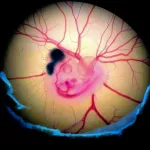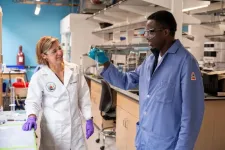(Press-News.org) A fungal infection has been shown to trigger a fruit fly’s own immune system to destroy brain cells leading to signs of neurodegeneration, a new study has found.
The paper published in PLOS Biology today found that a fungus called Beauveria bassiana was able to make the fly’s innate immune system trigger a process that kills neurons and glia in the brain, leading to more than half of flies dying after seven days compared to half of control samples living for nearly 50 days.
In experiments conducted by a team of academics from the University of Birmingham, fruit flies were exposed to B.bassiana in infection chambers. After three days exposure, the fungus had penetrated the blood-brain barrier and had made its way into the central brain.
The scientists found that the fungus is able to trick the fly’s immune system agents called Toll receptors to release two different responses. The Toll-1 receptor triggered the release of antimicrobial peptides (AMPs) as expected, which attack and try to kill pathogens. However, the fungus also provoked Toll-1 to trigger the production of another molecule called Sarm, which suppresses the immune response and kills brain cells instead.
Alicia Hidalgo, Professor of Neurogenetics at the University of Birmingham and corresponding author of the study said:
“We have shown a process for how fungi have evolved to trick the immune system to get into the brain. The fungus is detected by the receptor that does a normal process to induce innate immunity, but in the brain this can also trigger an immune-evasion pathway that induces cell death in the host brain instead.
“The key antagonist in the immune process is Sarm, a so-called master of destruction, that is causing cell death in the brain. The ability of B. bassiana to trick the fruit fly immune system into activating the master of destruction Sarm and kill cells enables spores to beat the blood-brain barrier and start feeding on brain cells.”
Dr Deepanshu Singh, who worked on the study for their PhD carried out at the University of Birmingham, and is now a post-doc at the University of Manchester, said:
“From an evolutionary perspective, these findings highlight the ongoing arms race between hosts and pathogens, where hosts enhance their immune mechanisms while pathogens evolve new strategies to evade immunity.
“It is important to stress that B. bassiana cannot affect humans. Some fungi have co-evolved with the host, so they will infect only particular hosts. B. bassiana infects multiple insect species, but not mammals. However, in principle, this study shows that other fungal infections could affect the human brain in analogous ways.”
END
Fungus ‘hacks’ natural immune system causing neurodegeneration in fruit flies
Exposure to B. bassiana fungal caused Toll receptors to trigger cell death across fly brains
2025-02-13
ELSE PRESS RELEASES FROM THIS DATE:
A new view on 300 million years of brain evolution
2025-02-13
Leuven, 14 February 2025 – In a new study published in Science, a Belgian research team explores how genetic switches controlling gene activity define brain cell types across species. They trained deep learning models on human, mouse, and chicken brain data and found that while some cell types are highly conserved between birds and mammals after millions of years of evolution, others have evolved differently. The findings not only shed new light on brain evolution; they also provide powerful tools for studying how gene regulation shapes different cell types, across species or different disease states.
Our brain, and by extension ...
Birds have developed complex brains independently from mammals
2025-02-13
The pallium is the brain region where the neocortex forms in mammals, the part responsible for cognitive and complex functions that most distinguishes humans from other species. The pallium has traditionally been considered a comparable structure among mammals, birds, and reptiles, varying only in complexity levels. It was assumed that this region housed similar neuronal types, with equivalent circuits for sensory and cognitive processing. Previous studies had identified the presence of shared excitatory and inhibitory neurons, as well as general connectivity patterns suggesting a similar evolutionary path in these ...
Protected habitats aren’t enough to save endangered mammals, MSU researchers find
2025-02-13
Images
EAST LANSING, Mich. – Tropical forests are massive biodiversity storehouses. While these rich swathes of land constitute less than one-tenth of Earth’s surface, they harbor more than 60% of known species. Among them is a higher concentration of endangered species than anywhere else on Earth.
However, these regions are also under immense pressure, as tropical land is rapidly being transformed for industrial and agricultural purposes.
Worldwide, regional governments and international groups are establishing new protected areas to slow further loss of threatened species. However, new research appearing in the journal PLOS Biology demonstrates ...
Scientists find new biomarker that predicts cancer aggressiveness
2025-02-13
HOUSTON ― Using a new technology and computational method, researchers from Fred Hutch Cancer Center and The University of Texas MD Anderson Cancer Center have uncovered a biomarker capable of accurately predicting outcomes in meningioma brain tumors and breast cancers.
In the study, published today in Science, the researchers discovered that the amount of a specific enzyme, RNA Polymerase II (RNAPII), found on histone genes was associated with tumor aggressiveness and recurrence. Hyper-elevated levels of RNAPII on these histone genes indicate cancer over-proliferation and potentially contribute to chromosomal changes. These findings point to the use of a new genomic technology as ...
UC Irvine astronomers gauge livability of exoplanets orbiting white dwarf stars
2025-02-13
Irvine, Calif., Feb. 13, 2025 — Among the roughly 10 billion white dwarf stars in the Milky Way galaxy, a greater number than previously expected could provide a stellar environment hospitable to life-supporting exoplanets, according to astronomers at the University of California, Irvine.
In a paper published recently in The Astrophysical Journal, a research team led by Aomawa Shields, UC Irvine associate professor of physics and astronomy, share the results of a study comparing the climates of exoplanets at two different stars. One is a hypothetical white dwarf that’s passed through much of its life cycle and is on a slow path ...
Child with rare epileptic disorder receives long-awaited diagnosis
2025-02-13
Researchers at Baylor College of Medicine, the Jan and Dan Duncan Neurological Research Institute (Duncan NRI) at Texas Children's Hospital, Baylor Genetics and collaborating institutions provided a long-awaited and rare genetic diagnosis in a child with Lennox-Gastaut syndrome, a type of developmental epileptic encephalopathy (DEE), associated with a severe, complex form of epilepsy and developmental delay.
Their recent study reports that a highly complex rearrangement of fragments from chromosomes 3 and 5 altered the typical organization of genes in the q14.3 region of chromosome ...
WashU to develop new tools for detecting chemical warfare agent
2025-02-13
Mustard gas, also known as sulfur mustard, is one of the most harmful chemical warfare agents, causing blistering of the skin and mucous membranes on contact. Chemists at Washington University in St. Louis have been awarded a $1 million contract with the Defense Threat Reduction Agency (DTRA) to develop a new way to detect the presence of this chemical weapon on the battlefield.
As with many chemical threats, quick identification of sulfur mustard is key to minimizing its damage, according to Jennifer Heemstra, the Charles Allen Thomas Professor of Chemistry in Arts & Sciences and principal investigator of the new DTRA grant.
“It’s ...
Tufts researchers discover how experiences influence future behavior
2025-02-13
Neuroscientists have new insights into why previous experiences influence future behaviors. Experiments in mice reveal that personal history, especially stressful events, influences how the brain processes whether something is positive or negative. These calculations ultimately impact how motivated a rodent is to seek social interaction or other kinds of rewards.
In a first of its kind study, Tufts University School of Medicine researchers demonstrate that interfering with the neural circuits responsible ...
Engineers discover key barrier to longer-lasting batteries
2025-02-13
Lithium nickel oxide (LiNiO2) has emerged as a potential new material to power next-generation, longer-lasting lithium-ion batteries. Commercialization of the material, however, has stalled because it degrades after repeated charging.
University of Texas at Dallas researchers have discovered why LiNiO2 batteries break down, and they are testing a solution that could remove a key barrier to widespread use of the material. They published their findings online Dec. 10 in the journal Advanced Energy Materials.
The team plans first to manufacture LiNiO2 batteries in the lab and ...
SfN announces Early Career Policy Ambassadors Class of 2025
2025-02-13
WASHINGTON — The Society for Neuroscience (SfN) has selected 10 members from a highly competitive applicant pool to participate in the Society’s annual Capitol Hill Day on March 11–13, 2025. The 10 Early Career Policy Ambassadors (ECPAs), representing many career stages and geographic locations, were chosen for their dedication to advocating for the scientific community, their desire to learn more about effective means of advocacy, and their experience as leaders in their labs and community.
The ambassadors are:
Izan Chalen, University of Illinois Urbana-Champaign
Nicole D’Souza, University of California, Riverside
Lana Ruvolo Grasser, PhD, Department ...
LAST 30 PRESS RELEASES:
University of Oklahoma researcher awarded funding to pursue AI-powered material design
Exploring how the visual system recovers following injury
Support for parents with infants at pediatric check-ups leads to better reading and math skills in elementary school
Kids’ behavioral health is a growing share of family health costs
Day & night: Cancer disrupts the brain’s natural rhythm
COVID-19 vaccination significantly reduces risk to pregnant women and baby
The role of vaccination in maternal and perinatal outcomes associated with COVID-19 in pregnancy
Mayo Clinic smartwatch system helps parents shorten and defuse children's severe tantrums early
Behavioral health spending spikes to 40% of all children’s health expenditures, nearly doubling in a decade
Digital cognitive behavioral treatment for generalized anxiety disorder
Expenditures for pediatric behavioral health care over time and estimated family financial burden
Air conditioning in nursing homes and mortality during extreme heat
The Alps to lose a record number of glaciers in the next decade
What makes a good proton conductor?
New science reporting guide published for journalists in Bulgaria
New international study reveals major survival gaps among children with cancer
New science reporting guide published for journalists in Turkey
Scientists develop a smarter mRNA therapy that knows which cells to target
Neuroanatomy-informed brain–machine hybrid intelligence for robust acoustic target detection
Eight SwRI hydrogen projects funded by ENERGYWERX
The Lundquist Institute and its start-up company Vitalex Biosciences Announces Strategic Advancement of Second-Generation fungal Vaccine VXV-01 through Phase 1 Trials under $40 Million Competitive Con
Fine particles in pollution are associated with early signs of autoimmune disease
Review article | Towards a Global Ground-Based Earth Observatory (GGBEO): Leveraging existing systems and networks
Penn and UMich create world’s smallest programmable, autonomous robots
Cleveland researchers launch first major study to address ‘hidden performance killer’ in athletes
To connect across politics, try saying what you oppose
Modulating key interaction prevents virus from entering cells
Project explores barriers to NHS career progression facing international medical graduates
Jeonbuk National University researchers explore the impact of different seasonings on the flavor perception of Doenjang soup
Two Keck Medicine of USC Hospitals named Leapfrog Top Teaching Hospitals
[Press-News.org] Fungus ‘hacks’ natural immune system causing neurodegeneration in fruit fliesExposure to B. bassiana fungal caused Toll receptors to trigger cell death across fly brains



